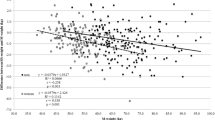Abstract
Objectives: Height and weight are key variables in epidemiologic research, including studies of reproductive outcomes. Optimally, this information is collected by trained study personnel. However, direct measurements are not always feasible. The purpose of this study was to investigate the accuracy of self-reported height and weight, as well as the resultant body mass index (BMI) calculated from self-reported height and weight (referred to as self-reported BMI), among a group of women of reproductive age according to select demographic variables.
Methods: A total of 381 women provided self-reported height, weight, and demographic information on a questionnaire for a study of contraceptive trends while attending a Family Medicine clinic. Height and weight were also abstracted from medical records for 275 of these study participants. Self-reported and measured values for height, weight, and BMI were compared using paired t-tests. Analysis of variance, chi-square tests, and Fisher’s Exact tests were used to examine how differences between self-reported and measured values varied by select demographic factors.
Results: Women underestimated weight by 4.6 pounds, overestimated height by 0.1 inches, and underestimated BMI by 0.8 kg/m2. All women, regardless of age, education, race/ethnicity, or marital status, underestimated their weight. These differences were statistically significant for all groups (p<0.01) with the exception of women with a high school education. Self-reported height and weight measures classified 84% of women into appropriate BMI categories.
Conclusions: Overall, self-reported height and weight were found to give an accurate representation of true BMI in this study. There were some demographic differences in the ability to accurately report height and weight, particularly with respect to race/ethnicity. Future studies should investigate these racial/ethnic differences among a larger population.
Similar content being viewed by others
References
Flegal KM, Carroll MD, Ogden CL, Johnson CL. Prevalence and trends in obesity among US adults, 1999–2000. JAMA 2002;288:1723–27.
Mokdad AH, Serdula MK, Dietz WH, Bowman BA, Marks JS, Koplan JP. The spread of the obesity epidemic in the United States. JAMA 1999;282:1519–22.
Mokdad AH, Bowman BA, Ford ES, Vinicor F, Marks JS, Koplan JP. The continuing epidemics of obesity and diabetes in the United States. JAMA 2001;286:1195–1200.
Mokdad AH, Ford ES, Bowman BA, Dietz WH, Vinicor F, Bales VS, Marks JS. Prevalence of obesity, diabetes, and obesity-related health risk factors, 2001. JAMA 2003;289:76–9.
National Institutes of Health. Clinical guidelines on the identification, evaluation, and treatment of overweight and obesity in adults: the evidence report. Obes Res 1998;6:S51–209.
Finkelstein EA, Fiebelkorn IC, Wang G. National medical spending attributable to overweight and obesity: how much, and who’s paying? Health Affairs Web Exclusive 2003;W3:219–26.
Stunkard AJ, Albaum JM. The accuracy of self-reported weights. Am J Clin Nutr 1981;34:1593–99.
Stewart AL. The reliability and validity of self-reported weight and height. J Chronic Dis 1982;35:295–309.
Palta M, Prineas RJ, Berman R, Hannan P. Comparisons of self-reported and measured height and weight. Am J Epidemiol 1982;115:223–30.
Stewart AW, Jackson RT, Ford MA, Beaglehole R. Underestimation of relative weight by use of self-reported height and weight. Am J Epidemiol 1987;125:122–6.
Le Marchand L, Yoshizawa CN, Nomura AMY. Validation of body size information on driver’s licenses. Am J Epidemiol 1988;128:874–7.
Rowland ML. Self-reported weight and height. Am J Clin Nutr 1990;52:1125–33.
Kuskowaska-Wolk A, Bergstrom R, Bostrom G. Relationship between questionnaire data and medical records of height, weight and body mass index. Int J Obes Relat Metab Disord 1992;16:1–9.
Roberts RJ. Can self-reported data accurately describe the prevalence of overweight? Public Health 1995;109:275–84.
Bolton-Smith C, Woodward M, Tunstall-Pedoe H, Morrison C. Accuracy of the estimated prevalence of obesity from self-reported height and weight in an adult Scottish population. J Epidemiol Community Health 2000;54:143–8.
Spencer EA, Appleby PN, Davey GK, Key TJ. Validity of self-reported height and weight in 4808 EPIC-Oxford participants. Public Health Nutr 2002;5:561–5.
Creinin MD, Roberts E. Body mass index, weight, and oral contraceptive risk. Obstet Gynecol 2005;105:1492.
Rossouw K, Senekal M, Stander I. The accuracy of self-reported weight by overweight and obese women in an outpatient setting. Public Health Nutr 2001;4:19–26.
Huber LRB, Hogue CJ, Stein AD, Drews C, Zieman M, King J, Schayes S. Contraceptive use and discontinuation: Findings from the Contraceptive History, Initiation, and Choice Study. Am J Obstet Gynecol 2006;194:1290–5.
Zaadstra BM, Seidell JC, Van Noord PA, te Velde ER, Habbema JD, Vrieswijk B, et al. Fat and female fecundity: prospective study of effect of body fat distribution on conception rates. BMJ 1993;306:484–7.
Jensen TK, Scheike T, Keidigin N, Schaumburg I, Grandjean P. Fecundability in relation to body mass and menstrual cycle patterns. Epidemiology 1999;10:422–8.
Bolumar F, Olsen J, Rebagliato M, Saez-Lloret I, Bisanti L. Body mass index and delayed conception: a European multicenter study on infertility and subfecundity. Am J Epidemiol 2000;151:1072–9.
Rich-Edwards JW, Spiegelman D, Garland M, Hertzmark E, Hunter DJ, Colditz G, et al. Physical activity, body mass index, and ovulatory disorder infertility. Epidemiology 2002;13: 184–90.
Brunner LR, Hogue CJ. The role of body weight in oral contraceptive failure: results from the 1995 National Survey of Family Growth. Ann Epidemiol 2005;15:492–9.
Brunner Huber LR, Hogue CJ. The association between body weight, unintended pregnancy, and contraception at the time of conception. MCHJ 2005;4:413–20.
Brunner Huber LR, Hogue CJ, Stein AD, Drews C, Zieman M. Increasing body weight and risk of oral contraceptive failure: a case-cohort study in South Carolina. In press at Ann Epidemiol.
Acknowledgments
The research for this paper was partially funded through HRSA Grant 2 T02 MC 00003-04 0, Dissertation Support for Applied Maternal and Child Health Epidemiology, and through the Sigma Delta Epsilon Fellowship awarded by Sigma Delta Epsilon/Graduate Women in Science.
Author information
Authors and Affiliations
Corresponding author
Rights and permissions
About this article
Cite this article
Brunner Huber, L.R. Validity of Self-reported Height and Weight in Women of Reproductive Age. Matern Child Health J 11, 137–144 (2007). https://doi.org/10.1007/s10995-006-0157-0
Received:
Accepted:
Published:
Issue Date:
DOI: https://doi.org/10.1007/s10995-006-0157-0



